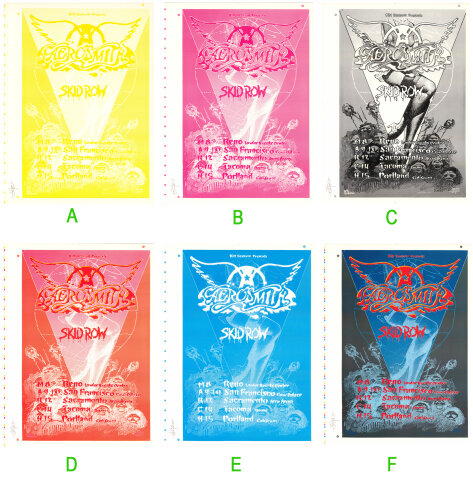Aerosmith Proof

Image may not exactly match item shipped.
This progressive proof variation exists in six distinct versions. Each was created during the color separation process to evaluate ink registration and tonal balance prior to the final print run. The variations display unique color stages, all measuring 23" x 31" and printed on identical stock.
The Progressive Proof A displays a yellow hue, capturing the base tone layer used to build subsequent color separations. It measures 23" x 31".
The Progressive Proof B presents a pink hue, highlighting the warm midtone stage of the printing process. It measures 23" x 31".
The Progressive Proof C shows a gray impression, reflecting the neutral balance stage prior to full color overlay. It measures 23" x 31".
The Progressive Proof D combines yellow and pink layers, resulting in a vibrant orange-toned blend that demonstrates the transitional phase between base and midtone applications. It measures 23" x 31".
The Progressive Proof E reveals a blue tone, representing the final color pass before completion. It measures 23" x 31".
The Progressive Proof F combines yellow, blue, and pink color layers, showcasing the nearly complete composition before the final black key plate was added. This version captures the rich midtone and highlight balance achieved through the overlay of these three primary inks. Printed on identical stock, it measures 23" x 31".
Rick Griffin grew up in the surfing culture of Southern California, a milieu which had a profound influence on his art. After high school, he worked on the staff of Surfer magazine and created the best-known surfing cartoon character of the time, Murphy. After his move to San Francisco in 1967, be began combining eclectic typefaces and decorative borders with brilliant colors in his concert posters. Griffin's compositions were complex without being illegible. A perfectionist, Griffin often applied dozens of overlays and redrew lettering again and again until he was satisfied. In the early 1970s, Griffin became a born-again Christian and religious themes dominated his work until his death in a motorcycle accident in 1991.